What to do in San Telmo, the best places to visit in this typical neighborhood of Buenos Aires.
It is one of the smallest neighborhoods in the city, but the second oldest of all. At its core is the soul of the Colonial style of Buenos Aires, with a mix of immigrant culture and diversity. In turn, it has some traditions of yesteryear, such as the San Telmo Fair that takes place on Sundays.
Beyond the attraction of the fair, you can visit the area during the week, every day, since it is a place of great tranquility. Its activity grows mostly on weekends. To fully enjoy it, we do recommend going on Sunday, since the air is breathed with more tradition thanks to the fair. And, if you go on that day, we invite you to join our San Telmo Tour, so that you know the history of this typical Buenos Aires neighborhood from the morning, ending in its huge Market, which we will tell you about below.
Now, let’s see everything related to What to do in San Telmo:
San Telmo Market
 It is a huge market that has continued to function since its inception back in the 19th century. In 1897, the architect Buschiazzo built it with the functionality of being a giant supplier of food, fruits and vegetables. Its structure has exposed iron arches. Currently, it has become a place to find a little of everything, from foods such as vegetables and meats, but, in addition, you will find endless antique stores. But, this is not all, a new gastronomy Pole has also been formed in recent times with variety and typical delicacies of our culture, with the option of eating at the bar, on the way or sitting down to enjoy a good traditional meal, a barbecue or gourmet sandwiches. Without a doubt, it is a must-see in the guide to What to do in San Telmo.
It is a huge market that has continued to function since its inception back in the 19th century. In 1897, the architect Buschiazzo built it with the functionality of being a giant supplier of food, fruits and vegetables. Its structure has exposed iron arches. Currently, it has become a place to find a little of everything, from foods such as vegetables and meats, but, in addition, you will find endless antique stores. But, this is not all, a new gastronomy Pole has also been formed in recent times with variety and typical delicacies of our culture, with the option of eating at the bar, on the way or sitting down to enjoy a good traditional meal, a barbecue or gourmet sandwiches. Without a doubt, it is a must-see in the guide to What to do in San Telmo.
San Telmo Fair and Dorrego Square
 On Sundays of every week you will find the streets of San Telmo dressed as a Fair. Originally, it was built around the perimeter of Dorrego Square (Plaza Dorrego), one of the oldest in the city after the famous Plaza de Mayo. With colonial buildings on all sides, the Church of San Telmo and classic bars adding more tradition to the place, antique stalls are displayed that sell objects of all kinds of art, styles and for all tastes. Here you will be able to find everything, and the prices are not that high, depending on what you are looking for, of course. This type of fair was originated by José María Peña, an architect who wanted to build the neighborhood and maintain its tradition by inviting everyone to walk the neighborhood and enjoy it in its essence. Without a doubt, it is a great plan to enjoy a whole Sunday of local tradition!
On Sundays of every week you will find the streets of San Telmo dressed as a Fair. Originally, it was built around the perimeter of Dorrego Square (Plaza Dorrego), one of the oldest in the city after the famous Plaza de Mayo. With colonial buildings on all sides, the Church of San Telmo and classic bars adding more tradition to the place, antique stalls are displayed that sell objects of all kinds of art, styles and for all tastes. Here you will be able to find everything, and the prices are not that high, depending on what you are looking for, of course. This type of fair was originated by José María Peña, an architect who wanted to build the neighborhood and maintain its tradition by inviting everyone to walk the neighborhood and enjoy it in its essence. Without a doubt, it is a great plan to enjoy a whole Sunday of local tradition!
San Pedro González Telmo Church
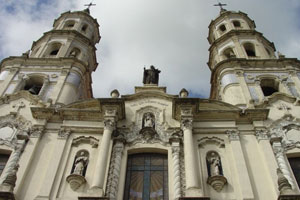 The name of the neighborhood comes from Santo Pedro González Telmo, who protected the sailors. A few steps from the Plaza Dorrego that we mentioned before, stands this Church that takes its same name. It is one of the most beautiful churches that the city has, of Jesuit construction and with that typical colonial essence. In the 19th and 20th centuries it was remodeled and covered with a baroque-Iberian facade. Inside, you will find a variety of paintings of various saints with the typical porteño style of filleting.
The name of the neighborhood comes from Santo Pedro González Telmo, who protected the sailors. A few steps from the Plaza Dorrego that we mentioned before, stands this Church that takes its same name. It is one of the most beautiful churches that the city has, of Jesuit construction and with that typical colonial essence. In the 19th and 20th centuries it was remodeled and covered with a baroque-Iberian facade. Inside, you will find a variety of paintings of various saints with the typical porteño style of filleting.
Ezeiza Family House | Passage La Defensa
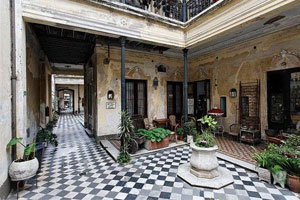 Going towards Defensa Street, almost Av. Independencia, you will find an old house whose construction dates back to 1876, belonging to the Ezeiza Family. This place is part of the last list of residences of the aristocracy that were built in the area in the period in which many families of good economic life moved to Recoleta. With Italian style, large patios, an old cistern that still stands today and beautiful iron columns. It maintained the typical colonial essence of a neighborhood mansion, which is why it continues to be one of the most beautiful places in the area. Currently, it bears the name of Pasaje la Defensa, transformed into a gallery of antiques, handicrafts and clothing stores.
Going towards Defensa Street, almost Av. Independencia, you will find an old house whose construction dates back to 1876, belonging to the Ezeiza Family. This place is part of the last list of residences of the aristocracy that were built in the area in the period in which many families of good economic life moved to Recoleta. With Italian style, large patios, an old cistern that still stands today and beautiful iron columns. It maintained the typical colonial essence of a neighborhood mansion, which is why it continues to be one of the most beautiful places in the area. Currently, it bears the name of Pasaje la Defensa, transformed into a gallery of antiques, handicrafts and clothing stores.
French Solar Gallery
 It is a walk of shops that is located on the site where Domingo French, a renowned Argentine patriot, has lived. Maintaining its old patios with beautiful flowers and plants, it is one of the most Instagram-friendly places in the city, as you won’t stop taking pictures of yourself! If you look up, you will see the sky covered with colored umbrellas, a trend that started in Portugal and has spread throughout the world, which gives a more magical tone to the place. It is a great option to enter here, not only to enjoy this beautiful colonial style and its vegetation, but also to have a photo book.
It is a walk of shops that is located on the site where Domingo French, a renowned Argentine patriot, has lived. Maintaining its old patios with beautiful flowers and plants, it is one of the most Instagram-friendly places in the city, as you won’t stop taking pictures of yourself! If you look up, you will see the sky covered with colored umbrellas, a trend that started in Portugal and has spread throughout the world, which gives a more magical tone to the place. It is a great option to enter here, not only to enjoy this beautiful colonial style and its vegetation, but also to have a photo book.
Minimum House
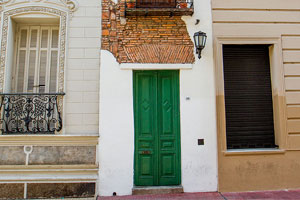 This small neighborhood also has another famous attraction and it is the narrowest house in the city. With a size of only 2.5 meters of façade, it is located in the San Lorenzo Passage and is recognized by the name of “The Minimum House”. There is a legend that says that this house was the home of a freed slave, and that this place would make a connection with our past in which the Afro-descendant population formed the majority of the population of the colonial city. Unfortunately, reality loses that illusion a bit, since it is said that the same architect who founded the fair to attract people to the area, José María Peña, is the one who affirmed that this site is the product of a subdivision of plots of a property still larger. Arguably, poorly divided. Despite these differences in theories for its existence, this house continues to be a point of admiration for everyone who visits it, given its curious and even tender physiognomy, and all the legends that exist around it.
This small neighborhood also has another famous attraction and it is the narrowest house in the city. With a size of only 2.5 meters of façade, it is located in the San Lorenzo Passage and is recognized by the name of “The Minimum House”. There is a legend that says that this house was the home of a freed slave, and that this place would make a connection with our past in which the Afro-descendant population formed the majority of the population of the colonial city. Unfortunately, reality loses that illusion a bit, since it is said that the same architect who founded the fair to attract people to the area, José María Peña, is the one who affirmed that this site is the product of a subdivision of plots of a property still larger. Arguably, poorly divided. Despite these differences in theories for its existence, this house continues to be a point of admiration for everyone who visits it, given its curious and even tender physiognomy, and all the legends that exist around it.
Zanjón de Granados
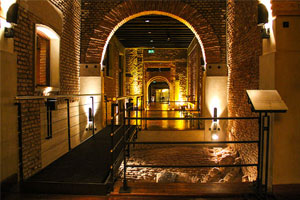 A businessman who bought an old house from 1830 to locate his gastronomy project in 1985, found some archaeological remains by accident. In the case of the tubing of an old stream that crossed the neighborhood, with its flows in the Río de la Plata. Known by the name of Tercero del Sur. It was, then, that he changed his gastronomic plans and dedicated himself completely to rescuing these tunnels of archaeological antiquity, which, today, you can visit.
A businessman who bought an old house from 1830 to locate his gastronomy project in 1985, found some archaeological remains by accident. In the case of the tubing of an old stream that crossed the neighborhood, with its flows in the Río de la Plata. Known by the name of Tercero del Sur. It was, then, that he changed his gastronomic plans and dedicated himself completely to rescuing these tunnels of archaeological antiquity, which, today, you can visit.
It is the only place where you can see the tunnels that exist under Buenos Aires in such an accessible and clear way. Unfortunately, the visit is with a fee and a guide, so we recommend that you schedule it in advance. If your visit to Buenos Aires is short, or only one day, you can skip this attraction and leave it for a second visit with more time.
Mafalda | Cartoon Walk
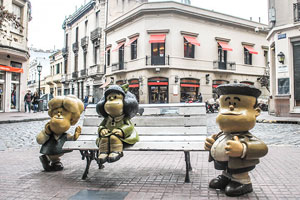 It is a walk with a string of statues of the best comic book characters in our country, mostly from the 60’s and 70’s. Under the name of “Paseo de la Historieta” you will meet very famous people like Mafalda who, according to Quino, its creator, this little girl loved by all, has always lived in San Telmo. You will find her with her friends Susanita and Miguelito at the corner of the intersection between Chile and Defensa streets. You will see that many people will line up at the bench where Mafalda is sitting, to get a souvenir photo with this little girl who has touched our hearts. Walk around this area paying attention, as there are several more characters!
It is a walk with a string of statues of the best comic book characters in our country, mostly from the 60’s and 70’s. Under the name of “Paseo de la Historieta” you will meet very famous people like Mafalda who, according to Quino, its creator, this little girl loved by all, has always lived in San Telmo. You will find her with her friends Susanita and Miguelito at the corner of the intersection between Chile and Defensa streets. You will see that many people will line up at the bench where Mafalda is sitting, to get a souvenir photo with this little girl who has touched our hearts. Walk around this area paying attention, as there are several more characters!
Lezama Park and National Historical Museum
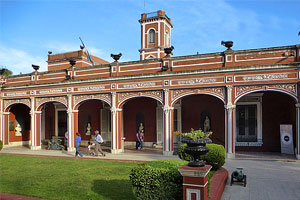 This enormous park was originally the garden of the mansion of José Gregorio Lezama, hence its name. This space was a donation from his widow to the city. With a romantic style, with a variety of statues, gazebos, paths, an old amphitheater and vessels that adorn it in its entirety. Here, too, you will find the monument of Pedro de Mendoza and the Russian Orthodox Church with its Moscow design. At the hand of Defensa street, you will see the National Historical Museum, which was formerly the old Lezama house with a beautiful Italian style. If you are interested in the history of the country, this is a visit that you cannot miss.
This enormous park was originally the garden of the mansion of José Gregorio Lezama, hence its name. This space was a donation from his widow to the city. With a romantic style, with a variety of statues, gazebos, paths, an old amphitheater and vessels that adorn it in its entirety. Here, too, you will find the monument of Pedro de Mendoza and the Russian Orthodox Church with its Moscow design. At the hand of Defensa street, you will see the National Historical Museum, which was formerly the old Lezama house with a beautiful Italian style. If you are interested in the history of the country, this is a visit that you cannot miss.
Caseros Avenue
 It is the avenue that separates the neighborhoods of San Telmo and Barracas. Here, most of the picturesque buildings were built. Currently, it is a focus of gastronomy with a huge variety of restaurants and bars for all styles. You will also find the “conventillo de los ingleses” which is the houses built for the British who worked on the southern railway, in typical European style.
It is the avenue that separates the neighborhoods of San Telmo and Barracas. Here, most of the picturesque buildings were built. Currently, it is a focus of gastronomy with a huge variety of restaurants and bars for all styles. You will also find the “conventillo de los ingleses” which is the houses built for the British who worked on the southern railway, in typical European style.
To learn more about the neighborhoods of Buenos Aires, as well as What to do in San Telmo, here is a link to more information!


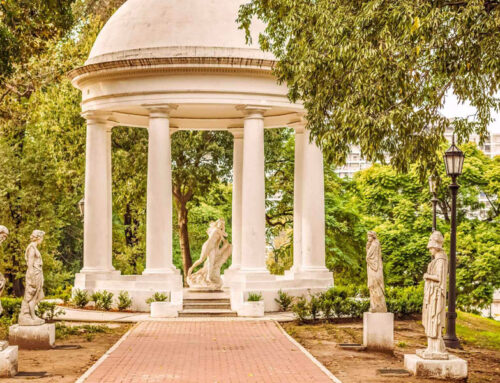
Leave A Comment